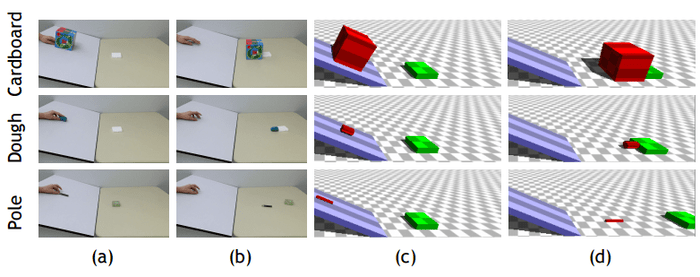MIT's AI System 'Galileo' Mimics Humans In Predicting How Objects Move
The Computer Science and Artificial Intelligence Lab (CSAIL) at MIT has recently unveiled its sophisticated artificial intelligence project named 'GALILEO'. Human beings can perceive the concept of volume in three dimension easily, but for robots it is one of the most challenging tasks. 'Galileo' not only comprehends a 3D object, but can also quantify and track the movement of the object with its advanced mechanism. Moreover, it can react according to actions in real time, almost matching human reflex action.

MIT researchers initially used the concept of human cognition and senses to weave a preliminary idea of Galileo’s personality. Galileo's computational model has trained itself on real-world videos, using a “3-D physics engine†to simulate human intuition. Galileo can deduce the physical properties of objects, predict and act according to the outcome of physical events. Lead author, Ilker Yildirim and CSAIL PhD student Jiajun Wu, referred to the reaction of Galileo on a ramp scenario, where it could accurately infer the density of an object, and whether it would float or not.

Jiajun wu and llker Yildirim
Contemporary research on neuroscience indicates that in order to predict the outcomes of general events, the human brain relies on a natural “physics engine†that processes noisy but concrete physical laws which govern real world objects. To make Galileo as efficient as humans, scientists introduced 3 sets of jobs, that have proven to be the right choice to train him in the process of ‘being human’.
The first test consisted of 150 videos that depict physical events involving objects of 15 different materials, from cardboard and foam to metal and rubber which challenged Galileo to draw a dataset of objects and their various physical properties, including shape, volume, mass, friction, and position in space.
The 2nd training comprised a reality check by Bullet, a 3-D physics engine often used to create special effects for movies and video games. In the 3rd test, the research team incorporated a deep-learning algorithm in Galileo which helps to further improve its predictions, mimicking a human as far as possible.
To asses Galileo’s predictive power, it was made to analyse a series of events concerning different physical properties such as gravity, inclination and distance. Galileo made mistakes similar to human beings, implying that human scene understanding is essentially a probabilistic simulation.
You can interact with Galileo #-Link-Snipped-# by asking him questions and reading his predictions.
Source: <a href="https://news.mit.edu/2016/csail-computer-model-matches-humans-predicting-how-objects-move-0104" target="_blank" rel="nofollow noopener noreferrer">Computer model matches humans at predicting how objects move | MIT News | Massachusetts Institute of Technology</a>

physics prediction system videos of collisions
From the Turing test to Multiagent systems, artificial intelligence is predicted to follow the pattern of an arthropod's lifecycle. However this field of science and engineering is still relatively new and encompasses a wide variety of subfields such as cognitive science, philosophy, mathematics, economics, neurology, control theory and computer science.
MIT researchers initially used the concept of human cognition and senses to weave a preliminary idea of Galileo’s personality. Galileo's computational model has trained itself on real-world videos, using a “3-D physics engine†to simulate human intuition. Galileo can deduce the physical properties of objects, predict and act according to the outcome of physical events. Lead author, Ilker Yildirim and CSAIL PhD student Jiajun Wu, referred to the reaction of Galileo on a ramp scenario, where it could accurately infer the density of an object, and whether it would float or not.

Jiajun wu and llker Yildirim
The first test consisted of 150 videos that depict physical events involving objects of 15 different materials, from cardboard and foam to metal and rubber which challenged Galileo to draw a dataset of objects and their various physical properties, including shape, volume, mass, friction, and position in space.
The 2nd training comprised a reality check by Bullet, a 3-D physics engine often used to create special effects for movies and video games. In the 3rd test, the research team incorporated a deep-learning algorithm in Galileo which helps to further improve its predictions, mimicking a human as far as possible.
To asses Galileo’s predictive power, it was made to analyse a series of events concerning different physical properties such as gravity, inclination and distance. Galileo made mistakes similar to human beings, implying that human scene understanding is essentially a probabilistic simulation.
The project result was presented at the Conference on Neural Information Processing Systems (NIPS) in Montreal, and was co-authored by postdoctoral student Joseph Lim, Professor William Freeman and Professor Joshua Tenenbaum of the Department of Brain and Cognitive Sciences. The research team concluded the press interview by emphasizing that their future goal was to build robots which can not only assist human beings in the real world, but also emulate us(humans) in various aspects.You can interact with Galileo #-Link-Snipped-# by asking him questions and reading his predictions.
Source: <a href="https://news.mit.edu/2016/csail-computer-model-matches-humans-predicting-how-objects-move-0104" target="_blank" rel="nofollow noopener noreferrer">Computer model matches humans at predicting how objects move | MIT News | Massachusetts Institute of Technology</a>
0
